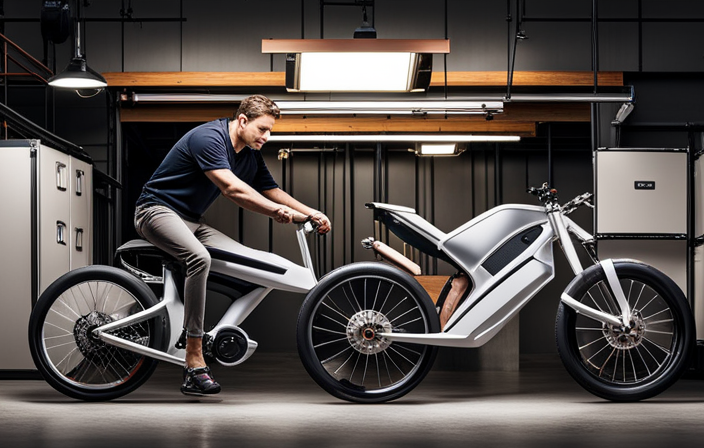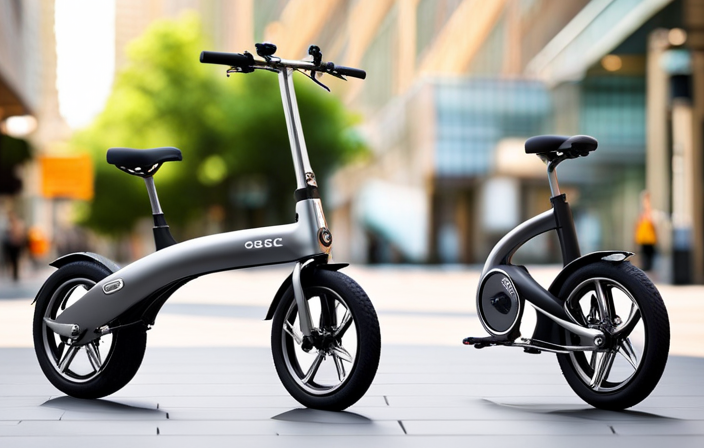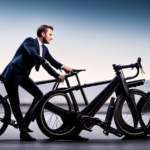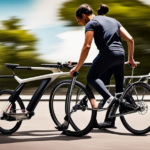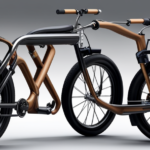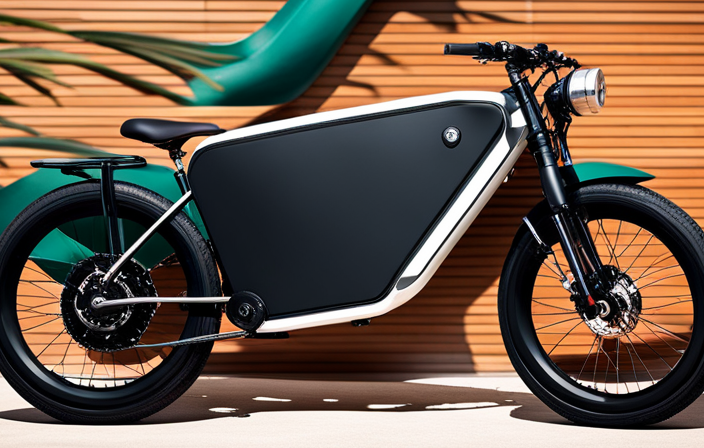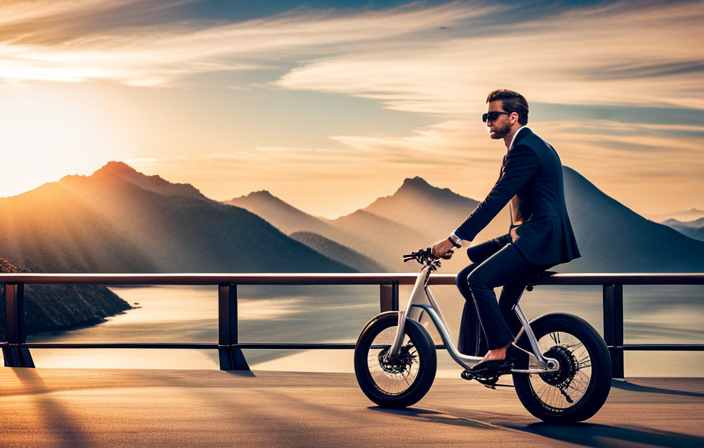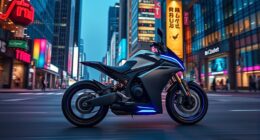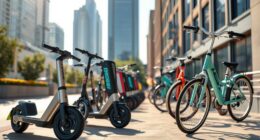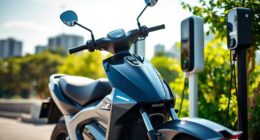If you’ve ever fantasized about cruising through urban streets on your very own electric bike, then this article is perfect for you. By having some knowledge and the correct parts, you can convert a regular bicycle into a robust, eco-friendly means of transportation.
In this guide, I’ll walk you through the step-by-step process of home making an electric bike. From understanding the components to troubleshooting common issues, get ready to embark on an electrifying journey towards a sustainable and exhilarating ride.
Key Takeaways
- Choose the right gear ratio to optimize power output
- Familiarize yourself with legal regulations and safety considerations
- Regularly check and tighten bolts and screws to ensure a safe ride
- Practice smooth braking techniques to improve efficiency and prolong brake life
Understanding Electric Bike Components
Understanding the components of an electric bike is crucial for building one at home. To begin, it is essential to grasp the intricacies of battery technology.
Lithium-ion batteries are commonly used in electric bikes due to their high energy density and long lifespan. It is important to consider factors such as voltage, capacity, and weight when selecting a battery for your electric bike.
Additionally, exploring different motor types is vital. There are three main types: hub motors, mid-drive motors, and friction drive motors. Each type has its advantages and disadvantages, and the choice depends on your specific needs and preferences.
Hub motors are the simplest and most common, while mid-drive motors provide better balance and efficiency. Friction drive motors are lightweight but may have less torque.
Understanding these components will help you make informed decisions when building your own electric bike.
Choosing the Right Bicycle for Conversion
To choose the right bicycle for conversion, you’ll need to consider factors such as the frame size, weight, and type of terrain you’ll be riding on.
The bicycle frame is crucial as it determines the stability and durability of your electric bike. Look for a frame that is sturdy enough to handle the additional weight of the electric components.
Additionally, consider the battery capacity when choosing a bicycle. A larger battery capacity will provide you with more range and power, allowing for longer rides and better performance. It’s important to find a balance between a frame that can support the weight of the battery and the desired battery capacity.
Take your time to research and test different bicycles before making your final decision.
Selecting the Right Electric Conversion Kit
When selecting the right conversion kit for your electric bike, it’s important to consider factors such as compatibility, power output, and ease of installation.
- Choosing the Right Motor
- Brushless Hub Motors: These motors are quiet, efficient, and require minimal maintenance. They are available in various power outputs, ranging from 250W to 1000W, allowing you to choose the level of assistance you desire.
- Mid-Drive Motors: These motors are installed at the crankshaft, providing better weight distribution and improved handling. They offer higher torque and are ideal for hilly terrains or off-road adventures. However, they can be more complex to install and maintain.
- Geared Motors: These motors offer a good balance between power and efficiency. They provide a smooth and natural riding experience while still offering enough assistance on inclines.
Considering these factors will help you choose the right motor for your electric bike.
- Comparing Battery Options
- Lithium-ion (Li-ion) Batteries: These are the most common and popular option due to their high energy density, light weight, and long lifespan. They are available in different capacities, allowing you to choose the range that suits your needs.
- Nickel Metal Hydride (NiMH) Batteries: These batteries are cheaper but have a lower energy density compared to Li-ion batteries. They are bulkier and heavier, which may affect the overall weight and handling of your electric bike.
- Lead Acid Batteries: These batteries are the cheapest option but have the lowest energy density and lifespan. They are heavy, require regular maintenance, and may not provide sufficient power for longer rides.
Considering these factors will help you choose the right battery for your electric bike.
Taking these factors into account will ensure a smooth and enjoyable riding experience with your electric bike.
Installing the Electric Motor and Battery
To install the electric motor and battery, follow the manufacturer’s instructions carefully. Ensure all components are properly connected and secured.
Start by installing the controller and throttle. Secure the throttle tightly on a suitable spot on your bike’s handlebars. Mount the controller in a convenient location, accessible but protected from the elements.
Next, connect the motor to the battery. Identify the motor’s wiring connectors and match them with the corresponding connectors on the controller. Secure the connections with zip ties or electrical tape to prevent loose wiring.
Finally, connect the battery to the controller, aligning the positive and negative terminals correctly. Double-check all connections before testing the electric bike for a safe and efficient ride.
Wiring and Connecting the Electrical Components
Once you have carefully followed the manufacturer’s instructions, you should proceed with wiring and connecting the electrical components. This step is crucial in ensuring the proper functioning of your homemade electric bike.
Start by gathering all the necessary wires, connectors, and tools such as a soldering iron and flux. Use the soldering techniques recommended by the manufacturer to secure the connections between the wires and components. Make sure to insulate all exposed wires to prevent any short circuits.
Additionally, pay close attention to the battery management system to ensure the safety and longevity of your battery. Connect the battery to the motor controller using the provided connectors, following the specific instructions for your particular setup.
Double-check all connections and ensure everything is securely fastened before proceeding to the next step.
Ensuring Safety Measures and Proper Maintenance
It’s important to prioritize safety measures and proper maintenance when building and maintaining your DIY electric bicycle. To ensure your safety, always wear a helmet and other appropriate protective gear. Additionally, make sure to follow safety precautions such as double-checking all connections and securing loose wires. You should also regularly inspect and maintain your electric bike to prevent any potential accidents. Here is a maintenance checklist to help you stay on top of your bike’s upkeep:
- Check the tire pressure regularly to ensure optimal performance and stability.
- Inspect the brakes for wear and tear, and adjust or replace them as needed.
- Keep the chain clean and lubricated to prevent rust and promote smooth operation.
- Regularly inspect the battery and charging system, making sure all connections are secure and the battery is functioning properly.
By following these safety precautions and maintaining your electric bike, you can enjoy a safe and reliable ride every time.
Upgrading and Customizing Your Electric Bike
Now that I’ve ensured the safety measures and proper maintenance of my home-made electric bike, it’s time to take it to the next level by upgrading and customizing it.
One area I want to focus on is upgrading the brakes to improve the overall stopping power and control of the bike. By installing high-performance disc brakes, I can ensure better responsiveness and reliability, especially during high-speed rides or when navigating steep terrains.
Additionally, I’m considering adding suspension to my electric bike to enhance its comfort and handling capabilities. A front suspension fork will help absorb shocks and vibrations, providing a smoother ride and better traction on uneven surfaces.
These upgrades will not only enhance the performance of my electric bike but also make my riding experience safer and more enjoyable.
Tips for a Smooth and Efficient Ride
To have a smooth and efficient ride, you should focus on maintaining proper tire pressure and regularly lubricating the chain. These two simple tasks can greatly improve the performance of your electric bike.
Here are some additional tips to enhance your riding experience:
- Keep your battery life in mind by avoiding excessive acceleration and using pedal assist when needed.
- Choose the right gear ratio to optimize your power output and ensure a comfortable pedaling cadence.
- Adjust your suspension settings to match the terrain you will be riding on.
- Regularly check and tighten all bolts and screws to prevent any loose parts that could affect your ride.
- Practice smooth and controlled braking to maximize efficiency and prolong the life of your brakes.
By following these tips, you can enjoy a smoother and more efficient ride on your homemade electric bike.
Legal Considerations for Electric Bikes
Considering the legal regulations surrounding e-bikes is essential for a safe and compliant riding experience. Safety regulations vary by country and sometimes even by state or province. It is important to familiarize yourself with the specific laws in your area to ensure you are riding within the legal boundaries. In addition to safety regulations, it is also important to consider insurance coverage for your electric bike. While not always required, having insurance can provide peace of mind and financial protection in case of accidents or theft. It is recommended to check with your insurance provider to see if they offer coverage for electric bikes and what the terms and conditions are. By adhering to safety regulations and having proper insurance coverage, you can enjoy your electric bike with confidence and peace of mind.
| Safety Regulations | Insurance Coverage |
|---|---|
| Helmet required | Optional but recommended |
| Speed limits apply | Coverage for accidents and theft |
| Follow traffic laws | Terms and conditions may apply |
Troubleshooting Common Issues
If you’re experiencing common issues with your e-bike, troubleshooting can help resolve them. Identifying common problems is the first step towards finding a solution.
One common issue is a sudden loss of power. This can be caused by a faulty battery or a loose connection. To troubleshoot this, check the battery connections and ensure they are secure.
Another common issue is a non-responsive motor. This can be due to a faulty controller or a blown fuse. To troubleshoot this, inspect the controller for any signs of damage and replace if necessary.
Additionally, a noisy motor can indicate a problem with the bearings or the chain. Lubricating the bearings and adjusting the chain tension can help resolve this issue.
By using these troubleshooting techniques, you can keep your electric bike running smoothly.
Frequently Asked Questions
Can I convert any type of bicycle into an electric bike?
Yes, you can convert most types of bicycles into electric bikes. However, compatibility concerns should be considered. Performance comparisons between different types of bikes should also be evaluated to ensure optimal results.
How long does it take to install an electric conversion kit?
Installing an electric conversion kit is a breeze! In just a blink of an eye, you’ll have your bike transformed into an electric wonderland. However, be prepared for some challenges along the way. Here are some tips and tricks to ensure a smooth installation.
Is it possible to upgrade the battery on my electric bike?
Yes, it is possible to upgrade the battery on an electric bike. By upgrading the battery, you can increase the range of your bike, allowing for longer rides without the need for frequent recharging.
Do I need any special tools to install the electric motor and battery?
No, special tools are not required for installing the electric motor and battery. However, it is crucial to consider electric bike maintenance and choose the appropriate motor and battery based on factors like power, voltage, and compatibility with your bike’s frame and components.
Are there any restrictions on where I can ride my electric bike?
Electric bike safety is governed by electric bike laws, which vary by jurisdiction. It’s crucial to familiarize oneself with local regulations to know where one can ride. Restrictions may include specific speed limits, bike lane usage, and age requirements.
Conclusion
Well, there you have it folks! After hours of meticulous research, careful planning, and a few minor hiccups along the way, I have successfully transformed my ordinary bicycle into a magnificent electric bike.
Who needs to spend a fortune on a pre-made electric bike when you can have the satisfaction of creating your own? Not only did I save a ton of money, but I also gained a deeper understanding of the intricate components that make up this marvelous machine.
So, if you’re feeling adventurous and want to embark on this electrifying journey, just remember to choose your components wisely, follow the installation steps diligently, and don’t forget to customize your ride to truly make it your own.
Happy riding, my fellow DIY enthusiasts!
